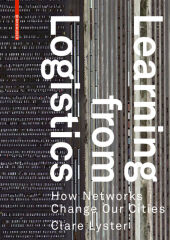 Neuerscheinungen 2016Stand: 2020-02-01 |
Schnellsuche
ISBN/Stichwort/Autor
|
Herderstraße 10
10625 Berlin
Tel.: 030 315 714 16
Fax 030 315 714 14
info@buchspektrum.de |

Clare Lyster
Learning from Logistics
How Networks Change our Cities
2016. 220 p. 20 b/w and 50 col. ill. 240 mm
Verlag/Jahr: BIRKHÄUSER BERLIN 2016
ISBN: 3-03-821470-1 (3038214701)
Neue ISBN: 978-3-03-821470-0 (9783038214700)
Preis und Lieferzeit: Bitte klicken
Im 19. Jahrhundert bildeten Eisenbahntrassen und Kanäle gleichzeitig Gerüst und Motor für die Stadtentwicklung. Diese Rolle übernehmen heute die globalen Daten- und Warenströme - so die These der Autorin. Die Material- und Kommunikationsfluss stellt gleichsam die DNA unserer Umwelt dar. Diese Entwicklung hat enorme und zum Teil noch unabsehbare Auswirkungen auf unsere Städte. Logistik-Netze und deren komplexe Struktur machen zunehmend ihren Einfluss in vielen städtischen Bereichen geltend. Auch Gegenbewegungen zum Internet-Handel- als einem der greifbarsten Phänomene- formieren sich, wie die allgegenwärtige Kritik an den dazugehörigen Arbeitsbedingungen und der Trend zum regionalen Produkt zeigen. Die Autorin beschreibt die aktuelle Entwicklung und geht ihren Auswirkungen auf Architektur, Landschaftsarchitektur und Urbanismus nach: Die Fragen der heutigen Hypermobilität von Waren wie von Menschen finden Eingang in die Entwurfsarbeit und erzeugen neue Paradigmen für Architektur und Städtebau. Erste Ansätze einer Integration dieser Aspekte werden beispielhaft an urbanistischen Projekten vorgestellt.
In the 19th century railroads and canals provided both structure and motor for city development. This role has been taken over today by the global flow of data and products, as the author argues. Flow of material and communication is the DNA of contemporary environments. This development has enormous and partially unfathomable implications for our city fabric. Logistics networks and their complex structure increasingly bear upon many urban spheres. Counter trends to the ubiquitous internet retail trade - to name one of the most palpable phenomena - are gaining momentum as well, exemplified by the criticism of labor conditions in e-commerce and the trend to buy regional products from local stores. The author describes the current development and its impact on architecture, landscape architecture and urbanism: Aspects such as today´s hypermobility of both products and people have repercussions in design work and create new paradigms for architecture and urban design. Concepts for the integration of these new issues are introduced by a number of exemplary urban design projects.
Assistant Prof. für Architektur,Univ. of Illinois,Chicago.


